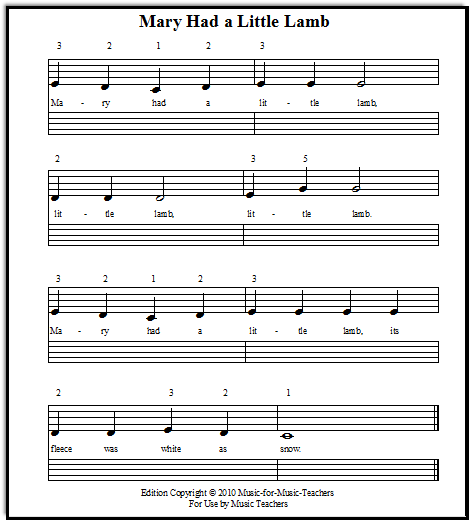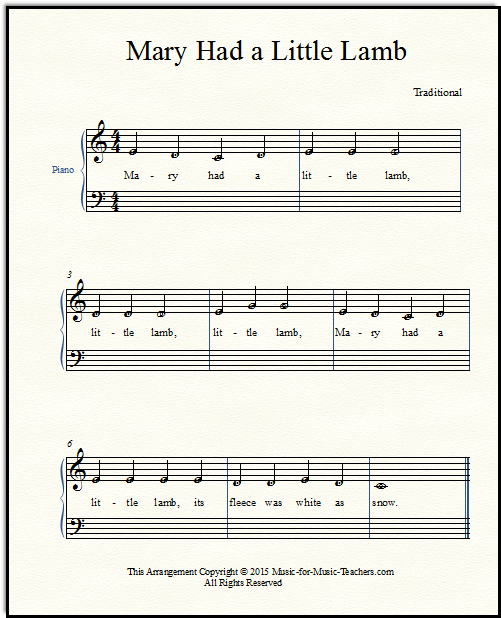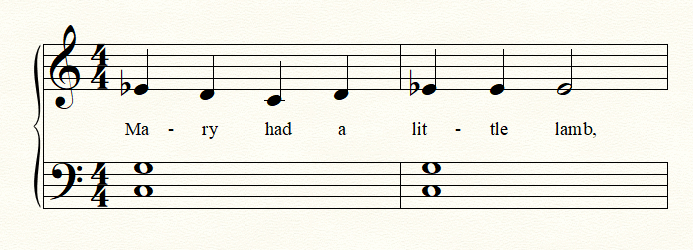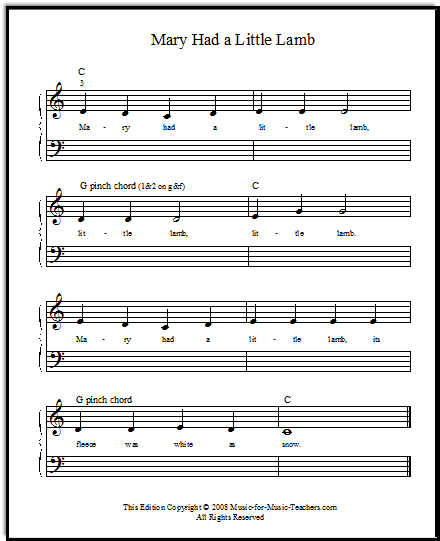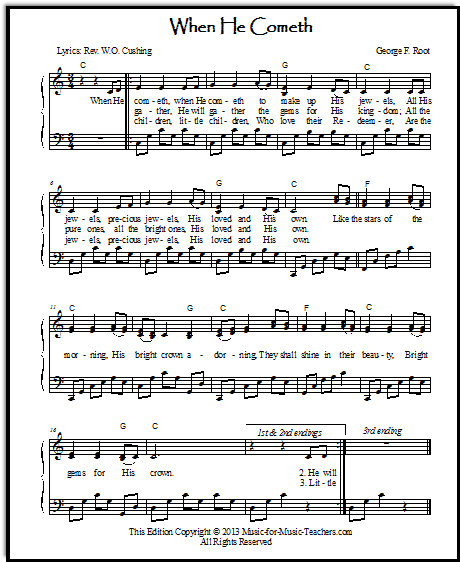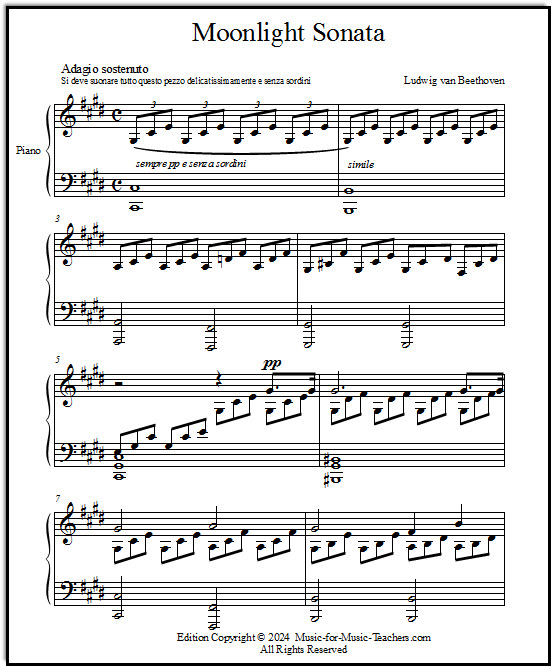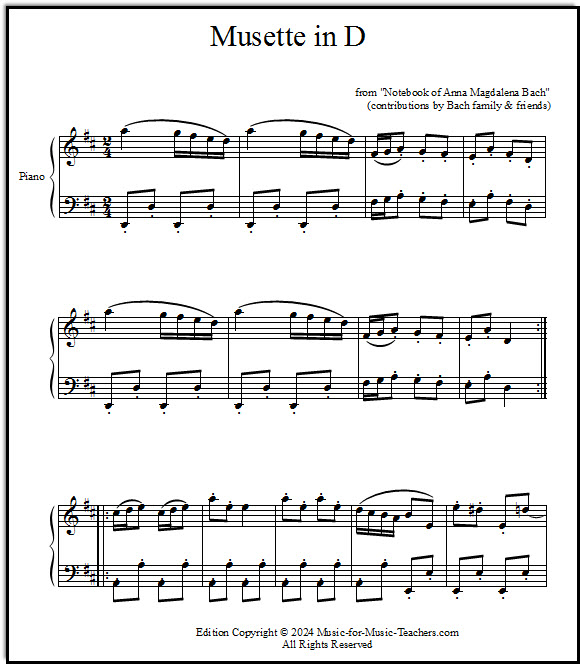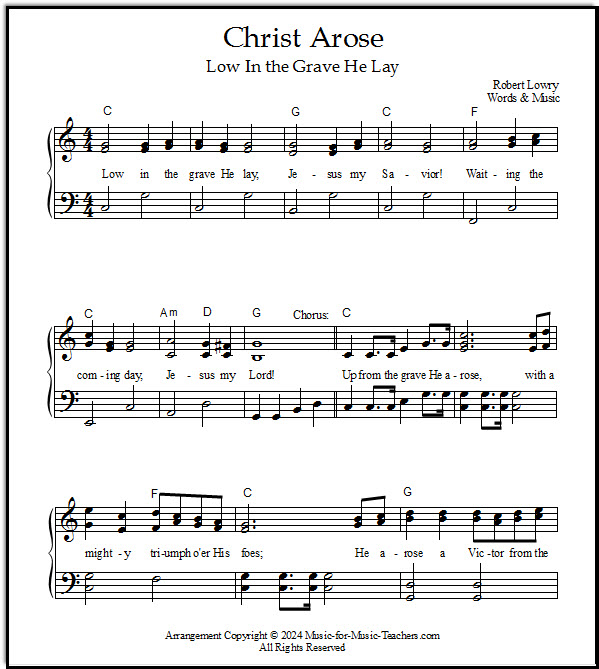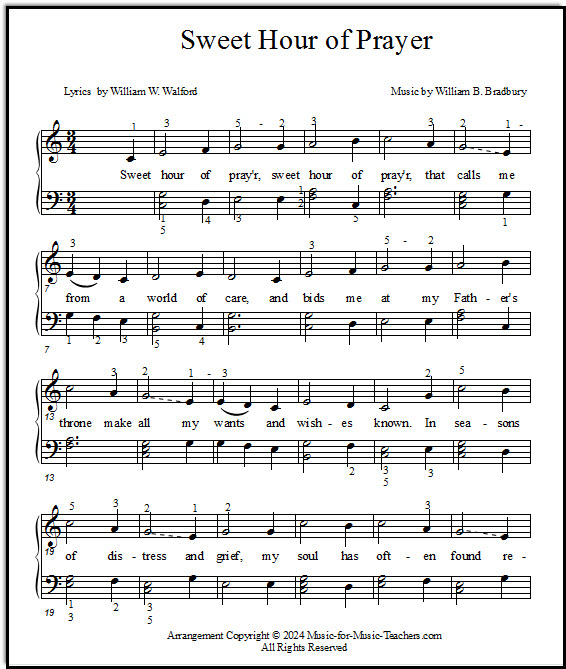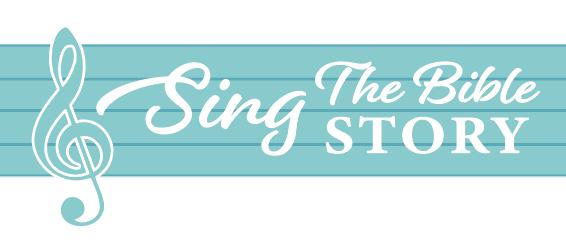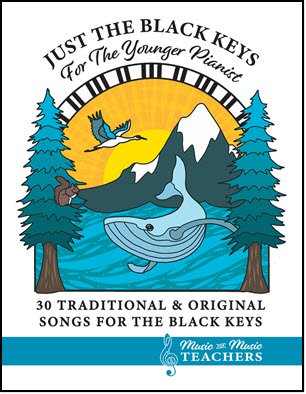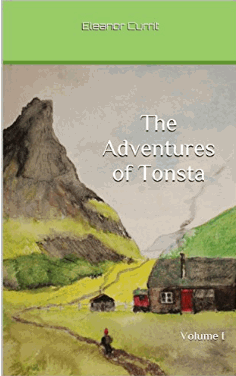Mary Had a Little Lamb
"Mary Had a Little Lamb is a NURSERY song - will my students play it?"
Absolutely - don't worry! For new beginners, even adults, they are just happy to play something that is recognizably music!
It is foundational for skill-building
Of all my piano music for beginning students, Mary Had a Little Lamb is the most necessary and the most versatile. Yes, it is just a nursery rhyme, but there is so much you can do with it!
You will see what I mean if you read to the bottom of this VERY LONG PAGE.
Please scroll down to find the free downloadable PDF links.
Sometimes you just have to give them what's good for them!
Though you would think children might turn up their noses at a nursery-rhyme song, only the occasional teenager looks mortified...
I always preface the piece with "Now I'm going to give you a world-famous song I give to all my students, even 'grown-ups.'"
And the pleasure of mastering a recognizable tune is such that they all end up enjoying it (for at least a little while!) - they are enjoying experiencing the skill of their fingers producing a real melody.
Why is it loaded with finger numbers?
Above, you see an arrangement with all the finger numbers (shades of John Thompson!)
Yes, this is a rote approach, but no, it won't kill your students to learn a piece by rote NOW AND THEN.
In fact, it will increase their comfort playing pieces by memory, or "by heart," as we sometimes call it. It's good ear training too.
Using lettered notes
Now here is a version even easier to read, if possible, using made-easy notes, known as Alpha-Notes:
There is so much you can do with this song! As piano music for kids, it is unbeatable for showing them how to use chords.
Now I'm going to show you the many ways I use Mary Had a Little Lamb, again and again, up to two or three years after the piano student has learned it the first time...
Adding a left hand
After the melody is well in hand, we start trying out an open C chord (c & g) with the LH (left hand), pressing the chord on beat 1 of each measure.
Yes, even though the melody could use a G chord as well. (We're coming to that!)

Usually I will have them play the LH while I play the RH, just to show them how it sounds, telling them that we'll try adding it to Mary Had a Little Lamb next lesson.
I don't draw notes for them, but show them how to make the chord. If they have been doing pentascales, it's easy for them to go "5, 4, 3, 2, 1" with the LH, and then hit 5 and 1 together.
Kids love adding the chord to MHaLL; it makes it sound like a real song.
Identifying chords
I point out (many times,generally) that chords start with the pinky, or bottom finger, on the name of the chord. It seems necessary to stress that"bottom" and "low" are LEFT on the piano ("where the men sing"), and "top" and "high" are RIGHT on the piano ("where the women and children sing").
Frequently kids and even adults will think that the C is where the LH thumb goes. No big deal---they'll get it eventually. Especially if they have been doing mirror scales, they will find that an easy mistake to make.
From major to minor
Now change it to MINOR - very cool!
I give it another couple of weeks, while other concepts and pieces are being learned, then come back to Mary Had a Little Lamb (they are still playing it) and turn it into scary, sad piano music.
That is, I have them lower the third finger of the melody, E, to Eb.
That changes the key from major to minor, and gives the song a sad or melancholy feeling, or even a hint of danger.
Some kids are electrified by this tiny change, and the power it gives them to create a mood! We re-name our new-sounding song "Mary LOST Her Little Lamb." Very fun. And we get to use the same open LH C chord.
Now contrast major with minor
When they are comfortable with that, then their assignment becomes to play "Mary Lost and Found" -- first sad (minor), then happy (back to major).
Minor sounds great down LOW, then we jump up to a higher octave for the happy version. This is very popular with most kids.
Adding in the V7 chord
The next change we make is adding a little G7 chord that I call a "pinch" chord.
It is just a 2-note inversion of the G7 chord.
The LH stays in its C chord position, but presses G & F together with the 1 & 2 fingers. This doesn't happen until students are very solid with the I chord, C.
See measure 3:
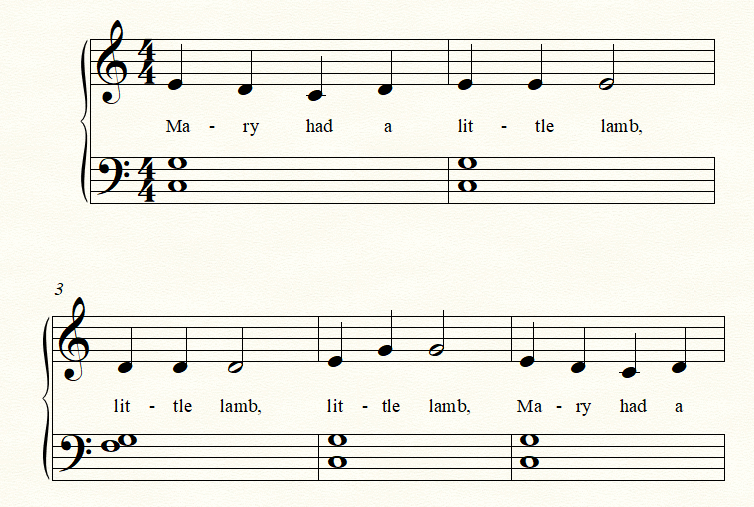
Don't bother writing in bass staff notes
I don't write notation onto their music (they wouldn't read it if I did, at this stage of their musical development!), but scratch some symbols up above the melody: "G pinch chord" and "G" & "F" with circles and "1" & "2" drawn inside the circles, for fingering.
Changing chords is much harder than playing just one chord, so it will take a little more time to polish. I'll take over the melody during the lesson at first, so they can focus on the new chord change.
This arrangement adds the chord symbols:
Please scroll down the page for the download links.
Transpose and get familiar with different keys
Now it's time to enlist this song in a new cause - transposing!
After a few months, when Mary Lost and Found is second nature, I come back to it again with an entirely new mission -- TRANSPOSING.
From the keys of C major and C minor, we move it up to D major and D minor.
This is rote learning - no notation
The ear will be helping out.
First D major -- I play it for them, with the necessary f#, and ask if they notice anything different.
I try to be patient, because if they can see what's going on without me just telling them, they'll remember it better.
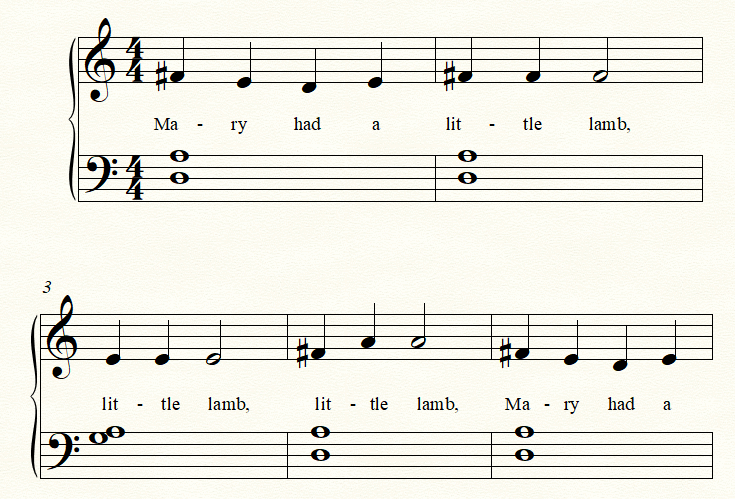
Students are frequently intrigued when you point out that D major and D minor are just the opposite in appearance to C major and C minor; C major (C) is "all white notes," and C minor (Cm) has a black note in the middle.
With D, and then Dm a week or two later, I make a big deal about how it is the "3" finger that makes all the difference. And their ear will tell them when it is wrong, almost all of the time.
Go as far as you can; you can always come back again later
We'll stay with C, Cm, D, and Dm for a while, then gradually, as the student is able, start moving to all the rest of the keys or positions.
If they are not yet grasping the formula for building a pentatonic major scale (Tonic, whole, whole, half, whole) then I draw little hollow circles on their lesson sheet to represent the 5 notes of MHaLL, and color in the ones that should be black keys with pen or pencil (or let them do it).
Even if the "Tonic, whole, whole, half, whole," is hard for them, we still say it together and make the scale at the lesson. Sometimes they'll forget how to do it at home...we just do it again.
The pentascale of B is the biggie!
Getting to the key of B is a big deal, and we have a Transposing Chart that a star goes onto when they have finished with the white note tonic keys. (This helps me keep track, as well as giving them a sense of accomplishment.)
If they have really understood the concept of transposing well, and memorized "Tonic, whole, whole, half, whole," we may go on to the black-note keys.
But, if they are burned out on this song, we may very well switch to something else and start over again at the key of C.
Now for the "black" keys!
Gb may be the best key to start with, as Mary Had a Little Lamb doesn't require the 4 finger, and so there will be only black notes, no white notes mixed in. (Except for that "pinch" chord!)
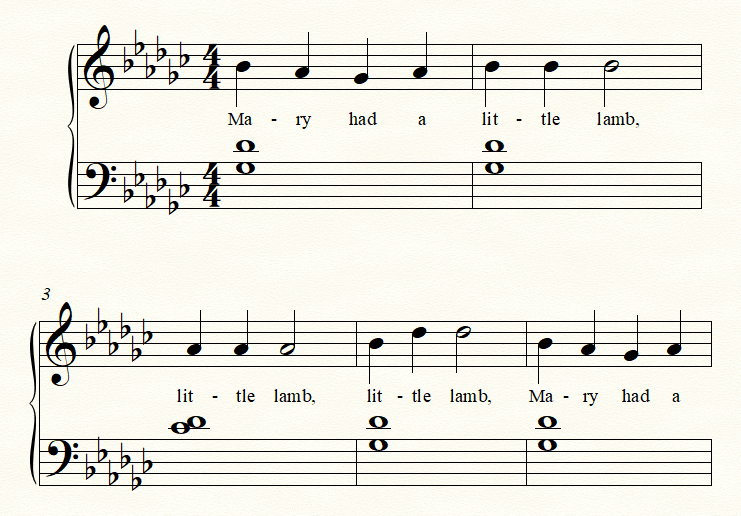
The keys of Ab and Db will feel similar to each other, but Bb and Eb will be a bit of a challenge.
(Whenever we are playing in B or B flat, I have a little mantra I say to them that helps them remember: "B is white on the bottom, black on the top. Bb is black on the bottom, white on the top. The B's are different than all the others!")
Some kids really love transposing. However, I often wait for the second or third transposed song before I have them try transposing into the black-note keys, especially if there was a struggle learning it!
Even older transfer students who read into Level 3 music have been known to have difficulties.
But transposing is so good for learning the finger patterns of the different keys, and for sharpening the ear.
More songs for transposing
When they're through with Mary Had a Little Lamb, I always have them help me pick the next piece to transpose.
Ode to Joy, Jingle Bells, and any piece that stays in a 5-finger pattern is usually a good bet. And even the minor pieces, such as "Snake Charmer" and "Irish Wedding," can be very satisfying.
A few of the songs in their lesson books lend themselves well to transposing, too, such as pieces at the end of their Primer, and "Firefly," "Girl on a Bicycle" and "Boy on a Bicycle" in the Faber Piano Adventure Level 1 book, and "Ice Cream" in the 2A book.
For a minor piece, "Forest Drums" is a lot of fun.
Starting to learn beautiful chord patterns
The last thing I use MHaLL for is chord pattern practice. The melody is so easy, that when it comes time for them to stretch themselves a little and start using broken chords in the LH, MHaLL is the perfect song.
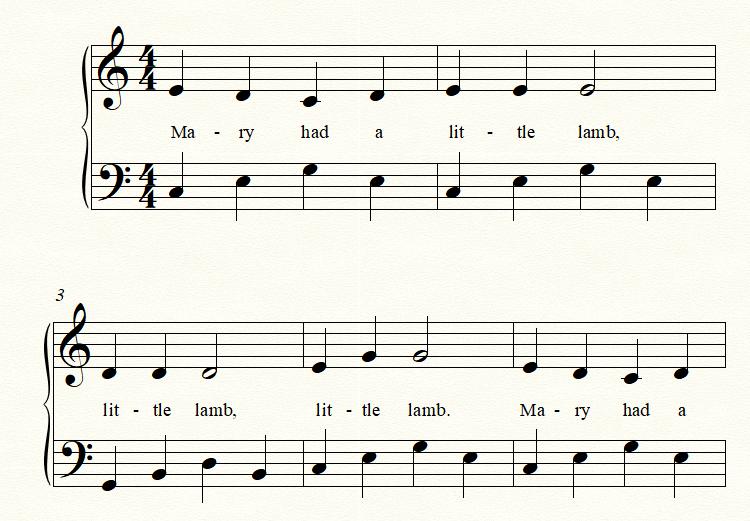
The RH can be put on "autopilot" and attention given to coordinating the two hands.
This is the song I use when kids are ready to start playing the pattern I call "broken chord stretch," which will open up the world of playing really beautiful chord songs to them.
It is a stepping stone to greater things!
One of my favorite piano studio stories happened the year the movie "Titanic" came out.
It seemed that every week, yet another young girl would come to her lesson and ask plaintively, "Can I play Titanic?"
Usually, the technique involved in the arrangement of the Titanic I was giving my students was just beyond where many of them were -- it was, in fact, full of "the broken chord stretch."
Eventually I recognized this desire in my students for the FABULOUS OPPORTUNITY it was!
I posted a sign on my studio door that said,
"Yes, I will give you Titanic, but only after you can play Mary Had a Little Lamb with broken chord stretch in all the keys!"
Let me tell you that what previously stretched out over months - the learning of C, then D, then E, then... well, you get the idea - what had previously taken MONTHS took only a couple of weeks to learn!
Such is the power of a motivating piece of music that students LONG TO PLAY.
Of course, this is for kids whose hands are large enough to make the octave stretch.
First they learn the chord pattern: a C open chord (C and G notes) plus another C on top.
The 2 finger goes where the 1 has always gone, on G. Use it like an anchor or a hinge, I tell them -- the 2 finger is a pivot...and don't try to hold the pinky (5th finger) down!
A new level of coordination
"5-2-1-2, c-g-c-g..." I play the melody to Mary Had a Little Lamb while they do the C chord.
Just the C chord, not the G chord. That's for later, when they've become pretty solid with the technique.

They will frequently come back to their next lesson having played this LH pattern all week long with their favorite hand,the right hand.
Oh well! We just do it again, and maybe have THEM try the melody of Mary Had a Little Lamb to it right then,so there will be no mistaking which hand does which.
"Can you rub your tummy and pat your head at the same time?" I ask them, demonstrating.
This is always fun to do, and illustrates for them that this requires a new kind of hand coordination.
Physical skills like this are fun to learn... it takes work, but I tell them to just TRY it with Mary Had a Little Lamb 1 time (1x) or 2x a day at first.
And to treat it just as when they learned to ride a bike... when they "crash," just start over again and see if they can get a little farther.
Some kids will get it right away. Others will struggle a bit.
But they will all enjoy it, especially when you ask them to put the pedal down and play it up high.
Mary Had a Little Lamb is TRANSFORMED.
Here are the sheet music PDF links:
Download Mary Had a Little Lamb, with plain notes in the treble clef
Download Mary Had a Little Lamb with chord symbols above the melody
More 5-finger songs at Music-for-Music-Teachers:
Cat Came Back (easiest version) - with fun-to-sing lyrics, many verses!
Erie Canal - Part I has only 5 notes, but is a satisfying introduction to this song
God is So Good - a sweet melody with sweet words
Jingle Bells - every child knows this one
Mary Had a Little Lamb - a song with many uses!
Ode to Joy, the famous tune by Beethoven
Pizza Please (Hot Cross Buns) - 3 notes, arranged for each hand
Sharks (3 notes, for left hand) - this is like the Jaws theme song
Snake Charmer - with fun lyrics and a mysterious minor melody
Tarantelle - the spider dance, with silly lyrics about tarantulas
When the Saints Go Marching In - with several arrangements!
Recent Articles
-
When He Cometh "Jewels" Hymn: Piano, Guitar, Vocal
When He Cometh or "Jewels" is an old-timey sounding hymn. Very sweet & very simple, this is one your piano students & vocalists can learn from! -
Moonlight Sonata: How to Play This Piece Full of Black Keys & Triplets
Moonlight Sonata: How to play this difficult piece full of black keys & triplets? Use large notes, lots of white space, & letters inside the note heads - easy! -
Bach Well-Known Pieces for Piano: the Musette in D, a Crowd-Pleaser!
Some of the best Bach well known pieces include those from the "Notebook for Anna Magdalena Bach." Among piano pieces, "Musette" is perhaps the most joyous! -
Christ Arose Sheet Music: Resurrection Day Song for Piano or Guitar
"Christ Arose" sheet music is perfect for Easter, or as many Bible believers say, "Resurrection Sunday." Mixing somberness & triumph, this song explains Easter. -
Sweet Hour of Prayer Hymn Sheet Music for Late Elementary Piano
Sweet Hour of Prayer hymn music has been around a long time, and is greatly loved still. Check out 4 arrangements for beginning to elementary piano, & guitar!
Interested in songs from the Bible for your students or church? Check out my other website, SingTheBibleStory.com!
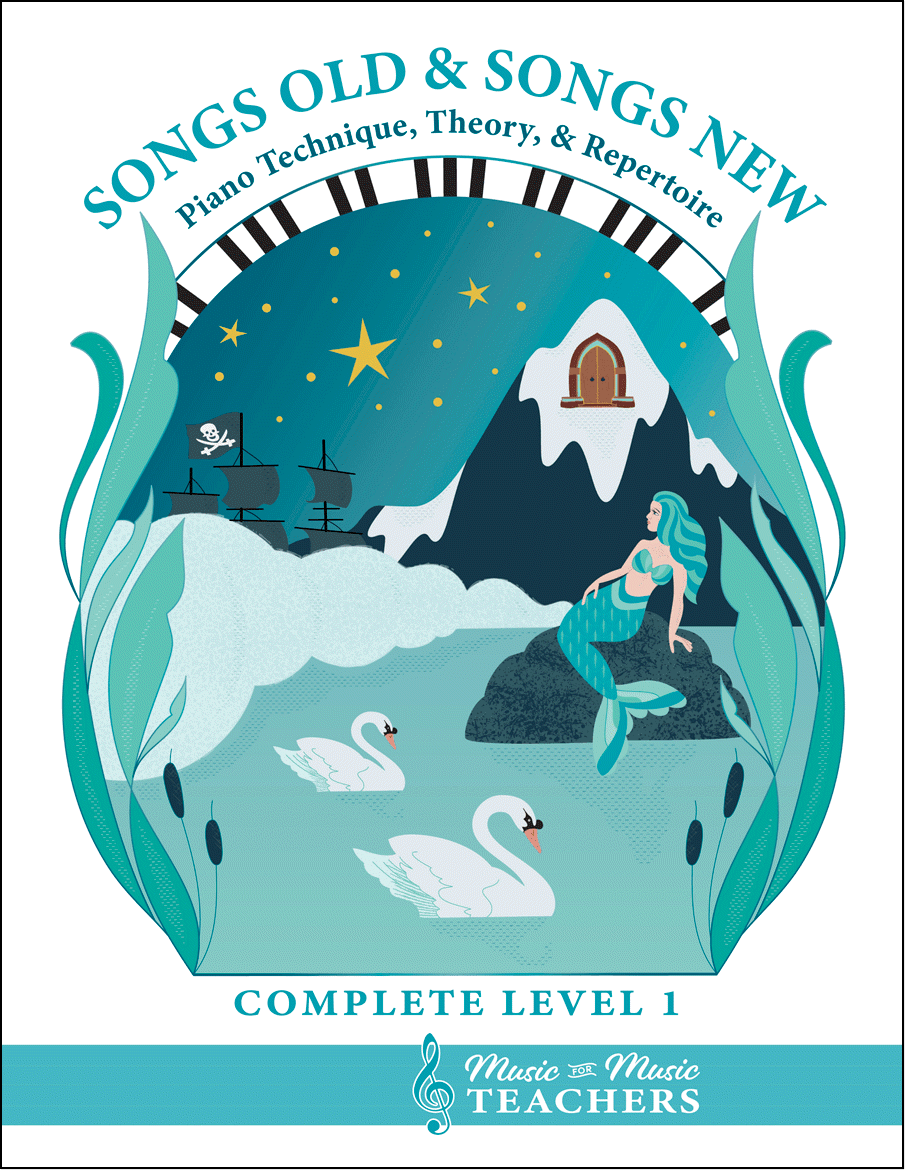
All the first-year material I give my beginner students.
Piano keyboard sheets, scales, chords, note-reading exercises, and over 256 pages of music!
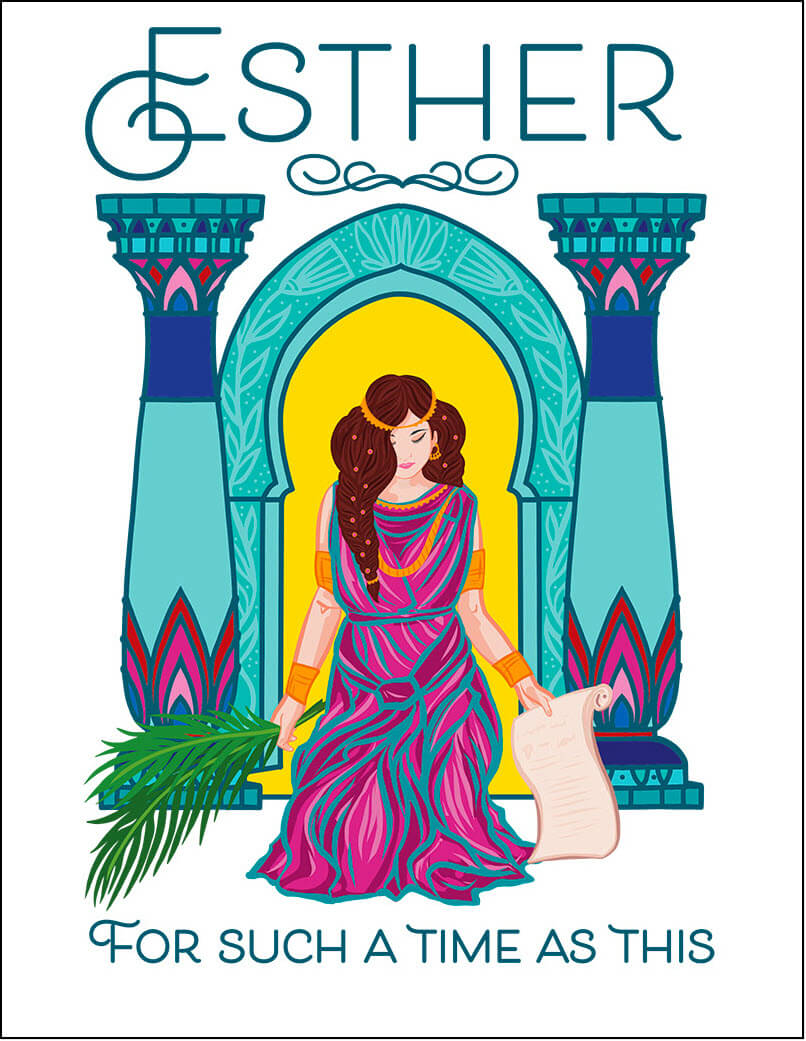
This beautiful song book for piano & voice "Esther, For Such a Time as This", available as a digital download, tells the riveting story of the time when Jews in ancient Persia faced a foe named Haman, and how a brave young queen risked her life to save her people.
A good choice for a singing story-teller, an operatic group, a short theater production, or a class of children!
This book is also available from Amazon as a paperback.
This book is available as a digital download from this site. Visit this page to see some free examples from the book.
It is also available from Amazon as a paperback!
This is the perfect easy start for little pianists.
And when they start reading white-key notes on the staff, this is a fun easy resource to say each week, "Choose a new black-key song at home this week and figure it out to show me next lesson!" They will be spending more time at the piano.
A perfect read aloud storybook
for little boys or girls.
The Adventures of Tonsta highlight the travels of a very young boy with a good heart, who goes about helping folk in trouble.
With a red cap on his head and a sack of tools slung over his shoulder, Tonsta seems to meet people in distress wherever he goes.
Lots of trolls in this book - including one who gives him a Christmas gift!
Sign up for "Take Note!" to see what's new every month.
Comments
Do you have a funny story about this music, or does it remind you of something you'd like to share with other readers? Do you have a question? I'd love to hear it!
Please note that all comments are moderated, and will not appear until I have approved them. Also, IF YOU ARE ASKING FOR MUSIC THAT IS NOT IN THE PUBLIC DOMAIN, YOUR REQUEST WILL BE IGNORED. That's pretty much any music written in the last 75 years...
What Other Visitors Have Said
Click below to see contributions from other visitors to this page...
I NEED HELP!
I'm 13 and I need some basic popular songs but I can't find any PLEASE HELP.
Dana replies:
Hello, 13-year-old; by the phrase "basic popular …
I Don't Get the Piano Keys
Umm I'm 12 and I don't get 123 does it mean C when there's white key black key white key black key when u play C??? I am very confused with piano and I …
My Son is Hooked
I've been introducing piano to my son on and off for a year or so, but he's not had much interest. Then I gave him "Monsters Everywhere" . He loved …
IPHONE PIANO
Check out this iphone/ipad app that teaches how to play Mary Had a Little Lamb (with the right hand) on piano ….
The creator of it says it's for a good …
You Guys are Awesome...
I'm learning piano and guitar and this site has helped with both!
Dana:
I'm glad this site has helped you! Keep checking back for more new …
About the Author

Hi, I'm Dana! (Say that like "Anna".) I'm the owner of Music-for-Music-Teachers.com, and a newer site, SingTheBibleStory.com.
Like some of you, I've been playing the piano since early childhood, and have added a few other instruments along the way, plus an interest in arranging and composing music.
You can find out more about me and the reason for this website at my About Me page.
